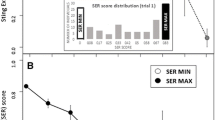Abstract
A target preparation has been developed for use in the study of intraspecific aggression in the golden hamster. Target animals selected for nonaggressiveness are treated with the nonnarcotic analgesic methotrimeprazine and fitted with a muzzle and harness. When subsequently attacked by aggressive animals, the targets’ locomotion and drug-elevated pain thresholds do not show systematic shifts if attack sessions are no longer than 45 min. Such targets also do not emit ultrasound during sessions. The use of such relatively invariant targets facilitates the study of changes in aggressive subjects over time and/or as function of experimental manipulation.
Similar content being viewed by others
References
ALBERTS, J. R., & GALEF, B. G. 1973. Olfactory cues and movement: Stimuli mediating intraspecific aggression in wild Norway rat. Journal of Comparative and Physiological Psychology, 85, 233–242.
AMLANER, Jr. C. J., & STOUT, J. F. 1978. Aggressive communications by Larus Glaucescens, Part VI: Interactions of territory residents with a remotely controlled, locomotory model. Behaviour, 66, 223–251.
AZRIN, N. H., HUTCHINSON, R. R., & HAKE, D. F. 1966. Extinction-induced aggression. Journal of the Experimental Analysis of Behavior, 9, 191–204.
AZRIN, N. H., HUTCHINSON, R. R., & SALLERY, R. D. 1964. Pain-aggression toward inanimate objects. Journal of the Experimental Analysis of Behavior, 7, 223–228.
BEATTY, W. M., & FESSLER R. G. 1977. Sex differences in sensitivity to electric shock in rats and hamsters. Bulletin of the Psychonomic Society, 10, 189–190.
BODNAR, R. J., KELLY, D. D., & GLUSMAN, M. 1978. Stress-induced analgesia: Time course of pain reflex alterations following cold water swims. Bulletin of the Psychonomic Society, 11, 333–336.
BRAIN, P. F. 1972. Effects of isolation/grouping on endocrine function and fighting behavior in male and female golden hamster (Mesocricetus auratus). Behavioral Biology, 7, 349–357.
BRAIN, P. F., & POOLE, A. V. 1974. Some studies on the use of “standard opponents” in intermale aggression testing in Tt albino mice. Behaviour, 50, 100–110.
BROWN, J. L., HUNSPERGER, R. W., & ROSVOLD, H. E. 1969. Defense, attack and flight elicited by electrical stimulation of the hypothalamus of the cat. Experimental Brain Research, 8, 113–129.
CONNOR, J. L. 1974. Waning and recovery of conspecific aggression in the house mouse (Mus musculus L.). Journal of Comparative and Physiological Psychology, 87, 215–227.
DENENBERG, V. H., GAULIN-KRAMER, E., GANDELMAN, R., & ZARROW, M. X. 1973. The development of standard stimulus animals for mouse (Mus musculus) aggression testing by means of olfactory bulbectomy. Animal Behaviour, 21, 590–598.
EVANS, W. O. 1961. A new technique for the investigation of some analgesic drugs on a reflexive behavior in the rat. Psychopharmacology, 2, 318–325.
FLOODY, O. R., PFAFF, D. W., & LEWIS, C. D. 1977. Communication among hamsters by high-frequency acoustic signals: II Determinants of calling by females and males. Journal of Comparative and Physiological Psychology, 91, 807–819.
GRANT, E. C., & MACKINTOSH, J. H. 1963. A description of the social postures of some laboratory rodents. Behaviour, 21, 246–259.
HILGER, W. N., & ROWE, F. A. 1975. Olfactory bulb ablation: Effects on handling reactivity, open field behavior and agonistic behavior in male and female hamsters. Physiological Psychology, 3, 162–168.
HUTCHINSON, R. R. 1972. The environmental causes of aggression. In J. K. Cole & D. D. Jensen, (Eds.), Nebraska symposium on motivation.Lincoln, Nebraska: University of Nebraska Press.
LERWILL, C. J., & MAKINGS, P. 1971. The agonistic behaviour of the golden hamster Mesocricetus auratus (Waterhouse). Animal Behaviour, 19, 714–721.
LESHNER, A. L., & NOCK, B. L. 1976. The effects of experience on agonistic responding: An expectancy theory interpretation. Behavioral Biology, 17, 561–566.
LEVISON, P. K., & FLYNN, J. P. 1965. The objects attacked by cats during stimulation of the hypothalamus. Animal Behaviour, 13, 217–220.
LOONEY, J. A., & COHEN, P. S. 1974. Pictorial target control of schedule-induced attack in White Carneaux pigeons. Journal of the Experimental Analysis of Behavior, 21, 571–584.
LORENZ, K. 1973. The comparative study of behavior (1939). In K. Lorenz & P. Leyhausen, (Eds.), Motivation of human and animal behavior. New York: Van Nostrand, Reinhold.
MURPHY, M. 1976. Olfactory stimulation and olfactory bulb removal: Effects of territorial aggression in male Syrian golden hamsters. Brain Research, 113, 05–110.
PAYNE, A.P. 1974. The effects of urine on aggressive responses by male golden hamsters. Aggressive Behavior, 1, 71–79.
PAYNE, A. P. 1977. Pheromonal effects of Harderian gland homogenates on aggressive behavior in the hamster. Journal of Endocrinology, 73, 191–192.
POTEGAL, M., BLAU, A. D., BLACK, M., & GLUSMAN, M. In press. Effects of castration of male golden hamsters on their aggression toward a restrained target. Behavioral & Neural Biology.
POTEGAL, M., MAROTTA, R., & GIMINO, F. 1975. Factors in the waning of muricide in the rat. I. Analyses of intra- and intersession decrement. Aggressive Behavior, 1, 277–290.
SALES, G. D. 1972. Ultrasound and aggressive behaviour in rats and other small mammals. Animal Behaviour, 20, 88–100.
SCOTT, J. P., & FREDERICSON, E. 1951. The causes of fighting in mice and rats. Physiological Zoology, 24, 273–309.
SIEGAL, S. 1956. Non-parametric statistics. New York: McGraw-Hill.
TAYLOR, G. T. 1975. Male aggression in the presence of an estrous female. Journal of Comparative and Physiological Psychology, 89, 246–252.
TELLEGEN, A., & HORN, J. M. 1972. Primary aggressive motivation in three inbred strains of mice. Journal of Comparative and Physiological Psychology, 78, 297–304.
Author information
Authors and Affiliations
Additional information
We would like to thank Dr. Owen Floody for his generous instruction in and use of his ultrasound apparatus at Bucknell University. The taxidermic preparation of hamsters was made possible through the kindness of Mr. Roland Hower of the Smithsonian Institution. Ms. Rebecca Armstrong helped in the preparation of Figure 1. This work was partially supported by N.I.M.H. Grant 1 R03 MH 28836-01 to M. Potegal.
Rights and permissions
About this article
Cite this article
Potegal, M., Blau, A., Black, M. et al. A Technique for the Study of Intraspecific Aggression in the Golden Hamster Under Conditions of Reduced Target Variability. Psychol Rec 30, 191–200 (1980). https://doi.org/10.1007/BF03394669
Published:
Issue Date:
DOI: https://doi.org/10.1007/BF03394669




